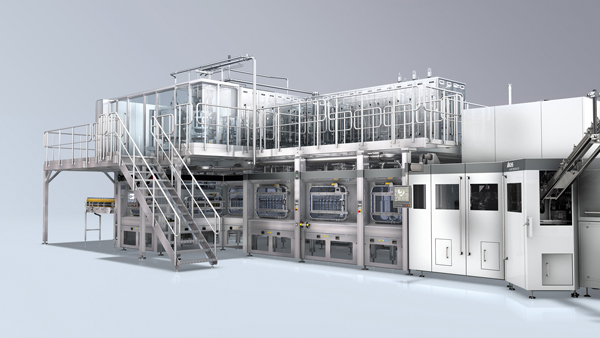With its new aseptic block for bottle sterilization KHS is setting standards in safety and hygiene. Beverage bottlers don’t have to compromise on performance here, however: thanks to its rotary filler, the block can produce triple the output of the linear filler.
Where maximum safety is of prime concern when filling sensitive beverages into PET bottles, KHS’ linear aseptic fillers have long proved themselves on the market. It’s thus only logical, then, that the Dortmund systems provider is now proud to also present a rotary aseptic filler for higher capacities whose hygienic properties are setting new standards. Here, the machine and systems manufacturer is consciously focusing on bottle sterilization that – unlike preform sterilization – can also be combined with the KHS FreshSafe PET coating system that provides additional product protection for sensitive beverages. In this procedure all potential germs are removed from the containers directly prior to filling. This gives bottlers more flexibility and greater availability during format changeovers than with preform sterilization, where changing the stretch blow molds disturbs the sterile state of the block. Bottle sterilization also allows lightweight containers to be gently handled with ease.
New filler design
The new rotary Innofill PET ACF-R filler has been combined with the energy-efficient InnoPET Blomax Series V stretch blow molder. The resulting InnoPET BloFill ACF-R aseptic block currently has a capacity of up to 36,000 1.0-liter bottles per hour as opposed to the linear fillers that work at a maximum rate of 14,000 bottles an hour. In the future the block will even be available with an output of up to 48,000 500-milliliter bottles every sixty minutes. In addition, the new plant engineering achieves a sterility of log 6 inside the bottles – which is equivalent to a reduction in germs of 99.9999%.
During development special attention was paid to the aseptic filler that was completely redesigned. One key feature was to limit the structure to a maximum of four smaller stars for the supply of hydrogen peroxide (H2O2) and activation and drying with sterile air. The stars are used in place of the previous large carousel. The benefits of this simplified technology are lower consumption figures and lower costs for installation and maintenance thanks to the machinery’s modular design and smaller footprint. “The sterile zone must be completely encapsulated and kept separate from the bottling shop,” says Manfred Härtel, filling product manager for KHS. “Large carousels need a liquid lock to separate them from the ambient air. This isn’t necessary on our version with the small stars, making the machine very much easier to configure and operate.”
High standard of hygiene
The InnoPET BloFill ACF-R is spread out over two levels: at ground level are the stretch blow molder, sterilization module, filler carousel and two-way servocapper. The process technology with the service module, H2O2 preparation, sterile compressed air production, cap sterilization unit and valve manifold are up on the platform.
The outsides and insides of the PET bottles are sterilized before they reach the filler’s aseptic zone where the sensitive products are filled into the containers and then sealed on the servocapper. In the hygiene area a measurable positive pressure is formed using sterile air generated by the block itself. This produces a flow of sterile air both in the direction of the bottle sterilization unit and through the capper to the bottle discharge via an airlock. The containers then undergo quality control (leak and fill level inspection) before traveling on to the dry section of the line.
A large number of fixed nozzles prevents spray shadows from being formed during sterilization of the bottle exterior. When the bottles enter the interior sterilization unit, the neck area is also individually sterilized. “What’s special about our sterilizer is that we’ve done away with the otherwise standard stars between the various processing stars,” Härtel explains. “So that this works, the sterilizer has been constructed so that no intermediate stars are needed and the main stars can directly interact with one another. To avoid collisions, we’ve also fitted the lances for interior sterilization with guide control.” These have movable arms that insert the spray lances into and retract them from the PET bottles. “All told, these new features make for a small aseptic zone and a high standard of hygiene. Together with the reduced number of stars and drives, this considerably reduces the machine’s overall footprint. Another quality hallmark of our bottle sterilization system is that after 24 hours less than 0.5 ppm of H2O2 residue remains in the bottles,” he states happily.










